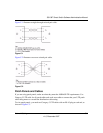
GS108T Smart Switch Software Administration Manual
Network Cabling C-5
v1.0, December 2007
If installing new cable, NETGEAR recommends using Category 5e cable, since it costs about the
same as Category 5 cable. If using the existing cable, be sure to have the cable plant tested by a
professional who can verify that it meets or exceeds either ANSI/EIA/TIA-568-A:1995 or ISO/
IEC 11801:1995 Category 5 specifications.
Length
The maximum distance limitation between two pieces of equipment is 100 m, as per the original
Ethernet specification. The end-to-end link is called the “channel.”
TSB-67 defines the basic link, which is the portion of the link that is part of the building
infrastructure. This excludes patch and equipment cords. The maximum basic link length is 295
feet (90 m).
Return Loss
Return loss measures the amount of reflected signal energy resulting from impedance changes in
the cabling link. The nature of 1000BASE-T renders this measurement very important; if too much
energy is reflected back onto the receiver, the device does not perform optimally.
Unlike 10BASE-T and 100BASE-TX, which use only two of the four pairs of wires within the
Category 5 cable, 1000BASE-T uses all four pairs of the twisted pair. Make sure all wires are
tested⎯this is important.
Factors that affect the return loss are:
• The number of transition points, as there is a connection through an RJ-45 to another
connector, a patch panel, or device at each transition point.
• Removing the jacket that surrounds the four pairs of twisted cable. NETGEAR strongly
recommends that, when RJ-45 connections are made, this is minimized to 1
1/4 inch (32 mm).
• Untwisting any pair of the twisted-pair cabling. It is important that any untwisting be
minimized to 3/8 inch (10 mm) for RJ-45 connections.
• Cabling or bundling of multiple Category 5 cables. This is regulated by
ANSI/EIA/TIA-568A-3. If not correctly implemented, this can adversely affect all cabling
settings.
Near End Cross Talk
Near End Cross Talk (NEXT) is a measure of the signal coupling from one wire to another, within
a cable assembly, or among cables within a bundle. NEXT measures the amount of cross-talk
disturbance energy that is detected at the near end of the link—the end where the transmitter is


















